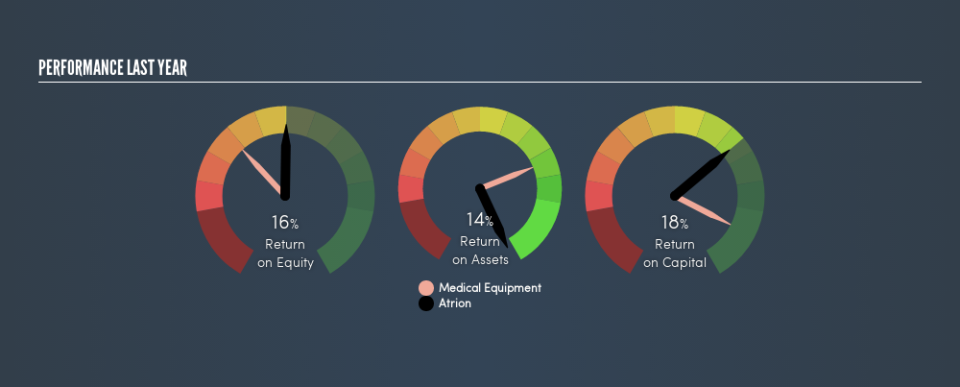Why You Should Like Atrion Corporation’s (NASDAQ:ATRI) ROCE

Today we are going to look at Atrion Corporation (NASDAQ:ATRI) to see whether it might be an attractive investment prospect. Specifically, we're going to calculate its Return On Capital Employed (ROCE), in the hopes of getting some insight into the business.
First of all, we'll work out how to calculate ROCE. Next, we'll compare it to others in its industry. Then we'll determine how its current liabilities are affecting its ROCE.
Return On Capital Employed (ROCE): What is it?
ROCE measures the amount of pre-tax profits a company can generate from the capital employed in its business. Generally speaking a higher ROCE is better. In brief, it is a useful tool, but it is not without drawbacks. Author Edwin Whiting says to be careful when comparing the ROCE of different businesses, since 'No two businesses are exactly alike.'
So, How Do We Calculate ROCE?
Analysts use this formula to calculate return on capital employed:
Return on Capital Employed = Earnings Before Interest and Tax (EBIT) ÷ (Total Assets - Current Liabilities)
Or for Atrion:
0.18 = US$41m ÷ (US$241m - US$11m) (Based on the trailing twelve months to March 2019.)
Therefore, Atrion has an ROCE of 18%.
View our latest analysis for Atrion
Does Atrion Have A Good ROCE?
One way to assess ROCE is to compare similar companies. Using our data, we find that Atrion's ROCE is meaningfully better than the 10% average in the Medical Equipment industry. We would consider this a positive, as it suggests it is using capital more effectively than other similar companies. Separate from Atrion's performance relative to its industry, its ROCE in absolute terms looks satisfactory, and it may be worth researching in more depth.
Atrion's current ROCE of 18% is lower than its ROCE in the past, which was 26%, 3 years ago. This makes us wonder if the business is facing new challenges. The image below shows how Atrion's ROCE compares to its industry, and you can click it to see more detail on its past growth.
When considering this metric, keep in mind that it is backwards looking, and not necessarily predictive. ROCE can be deceptive for cyclical businesses, as returns can look incredible in boom times, and terribly low in downturns. This is because ROCE only looks at one year, instead of considering returns across a whole cycle. You can check if Atrion has cyclical profits by looking at this free graph of past earnings, revenue and cash flow.
Do Atrion's Current Liabilities Skew Its ROCE?
Liabilities, such as supplier bills and bank overdrafts, are referred to as current liabilities if they need to be paid within 12 months. Due to the way the ROCE equation works, having large bills due in the near term can make it look as though a company has less capital employed, and thus a higher ROCE than usual. To counter this, investors can check if a company has high current liabilities relative to total assets.
Atrion has total assets of US$241m and current liabilities of US$11m. As a result, its current liabilities are equal to approximately 4.6% of its total assets. With low current liabilities, Atrion's decent ROCE looks that much more respectable.
The Bottom Line On Atrion's ROCE
If Atrion can continue reinvesting in its business, it could be an attractive prospect. Atrion shapes up well under this analysis, but it is far from the only business delivering excellent numbers . You might also want to check this free collection of companies delivering excellent earnings growth.
If you like to buy stocks alongside management, then you might just love this free list of companies. (Hint: insiders have been buying them).
We aim to bring you long-term focused research analysis driven by fundamental data. Note that our analysis may not factor in the latest price-sensitive company announcements or qualitative material.
If you spot an error that warrants correction, please contact the editor at editorial-team@simplywallst.com. This article by Simply Wall St is general in nature. It does not constitute a recommendation to buy or sell any stock, and does not take account of your objectives, or your financial situation. Simply Wall St has no position in the stocks mentioned. Thank you for reading.

